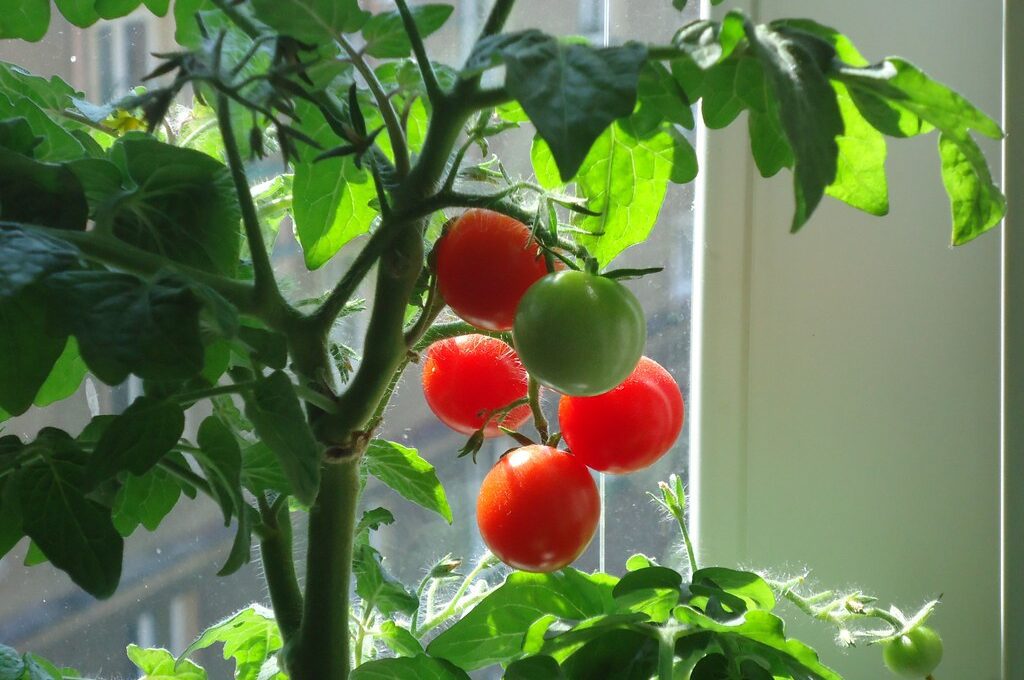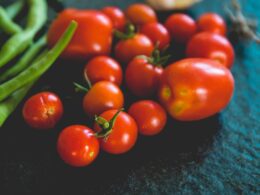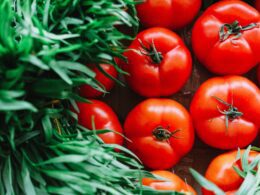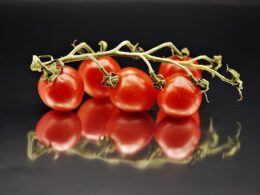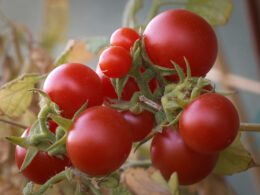You’ve always dreamed of growing plump, juicy tomatoes in your garden or on your windowsill. You imagine the satisfaction of picking them fresh and enjoying their rich flavor in a salad or sauce.
But what if you don’t feed your tomato plants properly? Will they still thrive and produce those mouthwatering fruits you crave?
In this article, we’ll dive into the world of tomato plant nutrition and explore the consequences of not feeding your precious plants enough. We’ll help you identify nutrient deficiencies and provide tips on proper feeding techniques to keep your tomatoes healthy, happy, and safe from harm.
By understanding how to care for these delectable delights, you’ll be well on your way to cultivating a bountiful harvest that satisfies both your taste buds and your desire for safety.
Understanding Tomato Plant Nutrition
It’s crucial to grasp the importance of proper nutrition for your tomato plants, as neglecting this aspect can lead to disastrous consequences and break a gardener’s heart.
Like any living organism, tomato plants require essential nutrients to grow strong and healthy, produce flavorful fruits, and fend off diseases that could potentially harm them.
Understanding the basics of tomato plant nutrition will not only ensure a bountiful harvest but also keep your garden safe from potential problems.
To give your tomatoes what they need, you should primarily focus on providing them with three key macronutrients: nitrogen (N), phosphorus (P), and potassium (K).
Nitrogen is vital for lush foliage growth, while phosphorus supports robust root development and flower production.
Potassium enhances overall plant health by boosting their immune system and helping them resist diseases.
Additionally, trace amounts of micronutrients such as calcium, magnesium, and iron are also necessary for maintaining your tomatoes’ well-being.
By regularly monitoring the health of your tomato plants and adjusting their nutrient intake accordingly, you’ll be able to avoid any deficiencies or imbalances that might otherwise jeopardize their growth.
Remember that it’s always better to take preventive measures than trying to fix issues later on.
So don’t skimp on feeding those hungry tomato plants – they’ll reward you with delicious fruits in return!
Consequences of Not Feeding Tomato Plants
Neglecting to provide proper nourishment for tomato plants may result in stunted growth, poor fruit production, and increased susceptibility to diseases. Without enough nutrients, your tomato plants won’t be able to develop strong root systems and sturdy stems, which are essential for supporting heavy fruit loads.
Additionally, a lack of necessary elements like nitrogen, phosphorus, and potassium can lead to discolored leaves and weak fruit sets. If you don’t feed your tomatoes properly, they’re more likely to fall victim to various pests and diseases.
A well-nourished plant has a better chance of fending off harmful insects like aphids or whiteflies that can cause significant damage. Moreover, healthy tomato plants are also more resistant to fungal infections such as blight or fusarium wilt that could otherwise devastate your crop.
To ensure the success of your tomato garden and protect the hard work you’ve already put into it, make sure you’re providing adequate nutrition for your plants by using an appropriate fertilizer or compost mixture. Regularly monitor their progress as they grow and adjust their feeding schedule as needed.
By taking these precautions, you’ll not only enjoy a bountiful harvest but also keep your precious tomato plants safe from harm’s way.
Identifying Nutrient Deficiencies
So, how can you tell when your tomato plants are lacking essential nutrients? Let’s dive into the signs of nutrient deficiencies and learn how to keep your garden thriving!
Identifying nutrient deficiencies in your tomato plants is crucial for their overall health and growth. Several key indicators can help you diagnose which nutrients are missing from your plant’s diet. Some common symptoms include yellowing leaves, stunted growth, poor fruit production, and weak stems.
To identify specific nutrient deficiencies in your tomatoes, look closely at the leaves. Nitrogen deficiency often presents itself as yellowing on older leaves near the base of the plant, while phosphorus deficiency causes dark green or purple-tinged foliage with slowed growth. Potassium-deficient plants may exhibit leaf edges turning brown and curling up along with reduced fruit quality. Additionally, calcium deficiency leads to blossom end rot – a common issue where black spots form on the bottom of fruits.
Addressing these nutrient deficiencies as soon as possible is vital for ensuring a bountiful harvest and healthy tomato plants. To correct any imbalances, first test your soil to determine its pH level and available nutrients. Then, amend your soil accordingly by adding appropriate fertilizers or organic matter such as compost or aged manure to provide essential nutrients needed for optimal growth.
Regularly monitoring the health of your tomato plants will not only lead to delicious produce but also create a safer environment for you to enjoy gardening without worry!
Can Not Feeding Tomatoes Cause Them to Be Picked Too Early?
Not feeding tomatoes can lead to the picking tomatoes prematurely consequences. When tomato plants don’t receive enough nutrients, they may not reach their full growth and maturity potential. This can result in fruit that is picked too early, affecting its flavor, color, and overall quality. Proper feeding ensures healthy plants and allows tomatoes to ripen naturally, enhancing their taste and appearance.
Proper Feeding Techniques for Tomato Plants
Imagine your tomato plants thriving with vibrantly green leaves and plump, juicy fruits – that’s what proper feeding techniques can do for them! To achieve this bountiful harvest, it’s essential to feed your tomato plants the right nutrients at the right time. Here are some tips on how to properly nourish your tomatoes:
- Start by choosing a high-quality tomato fertilizer: Look for a balanced N-P-K ratio (nitrogen, phosphorus, potassium), such as 5-5-5 or 10-10-10. Opt for an organic fertilizer if you prefer a more natural approach. Consider using a slow-release granular formula to provide steady nutrition over time.
Regular feeding is crucial in maintaining your tomato plant’s health and productivity. Begin fertilizing when transplanting seedlings into the garden or potting them up indoors. After that, feed every two to four weeks throughout the growing season. However, be mindful not to over-fertilize; too much can lead to excessive foliage growth at the expense of fruit production. Remember these points while feeding:
- Water-soluble fertilizers should be applied through drip irrigation or directly onto soil near plant roots.
- Granular fertilizers should be gently worked into the top inch of soil around each plant and watered thoroughly.
- Adjust feeding schedules based on factors like rainfall and temperature – during hot spells or periods of heavy rain, you may need to increase frequency slightly.
A well-fed tomato plant rewards you with outstanding flavor and abundant yields. By following these guidelines and closely monitoring your plant’s needs throughout its lifecycle, you’ll enjoy delicious tomatoes all season long. So go ahead and give those tomatoes some love – they’ll return the favor tenfold!
Tips for Growing Healthy and Productive Tomato Plants
Growing healthy and productive tomato plants starts with you! First, focus on soil preparation and maintenance to give your tomatoes the best foundation.
Next, learn about proper watering techniques and sunlight requirements to ensure they thrive throughout the season.
Soil preparation and maintenance
Without proper soil preparation and maintenance, your tomato plants won’t receive the essential nutrients they need to thrive and produce a bountiful harvest. It’s crucial to start with well-draining, nutrient-rich soil that has a slightly acidic pH level between 6.0 and 6.8.
To achieve this ideal environment for your tomatoes, incorporate organic matter like compost or aged manure into the soil before planting. This will not only improve its structure but also provide vital nutrients for your plants to grow strong and healthy.
Regularly monitoring and maintaining the condition of the soil throughout the growing season is equally important in ensuring a safe space for your tomatoes to flourish. Be sure to keep an eye out for any signs of nutrient deficiencies or pests that can compromise their health and productivity.
This might involve applying additional organic fertilizer if needed or using natural pest-control methods to protect your precious tomato plants from harm. By taking these proactive steps in preparing and caring for the soil, you’ll create a nurturing environment where your tomatoes can reach their full potential – providing you with peace of mind knowing that you’ve done everything possible to cultivate a successful crop.
Watering and sunlight requirements
Now let’s dive into the crucial aspects of watering and sunlight requirements, ensuring that your tomato plants stay healthy and yield a bountiful harvest. Adequate water and sunlight are essential for tomatoes to flourish, as they provide the necessary nutrients and energy for growth. To make sure your tomatoes are getting what they need, follow these simple guidelines:
-
Watering: Consistency is key when it comes to watering your tomato plants. Aim to provide them with 1 to 1.5 inches of water per week, either through rainfall or manual watering. Avoid overwatering or underwatering, as this can lead to problems such as blossom end rot or splitting fruits.
-
Sunlight: Tomatoes thrive in full sun exposure, so choose an area where they will receive at least six hours of direct sunlight each day. If possible, rotate your planting location every year to minimize disease build-up in the soil and ensure optimal light conditions.
By providing consistent water and ample sunlight, you’ll create a safe haven for your tomato plants to grow strong and produce delicious fruits for you to enjoy.
Remember that these basic needs are vital for their well-being; neglecting them could result in weak plants with low yields or potential disease issues.
Keep an eye on their progress throughout the growing season and adjust as needed – happy gardening!
Conclusion
So, if you don’t feed your tomato plants, they’ll likely suffer from nutrient deficiencies and poor growth. Remember to provide them with the proper nutrients and follow good feeding techniques for a healthy and productive tomato garden.
Don’t let your hard work go to waste! Keep these tips in mind and give your tomatoes the care they deserve for a bountiful harvest. Happy gardening!





